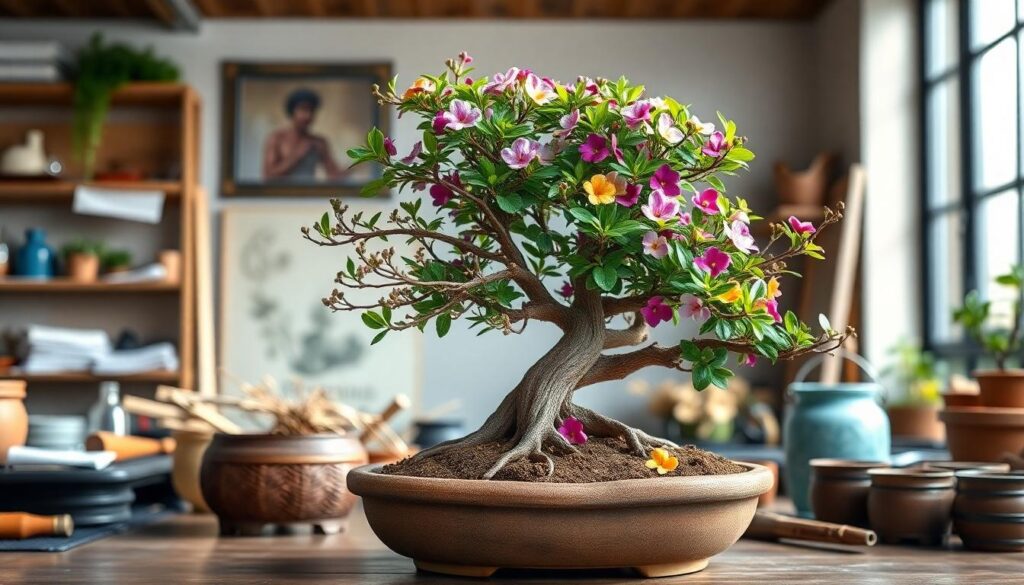Transforming a vinca plant into a stunning bonsai tree is an art form that combines patience, technique, and creativity. We’ve discovered that these resilient perennials, with their woody stems and elegant structure, make perfect candidates for bonsai cultivation—offering a unique alternative to traditional bonsai species.
Many plant enthusiasts overlook vincas when considering bonsai possibilities, but we’re here to change that perception. These versatile plants respond remarkably well to training and pruning, developing the characteristic aged appearance that makes bonsai so captivating. Whether you’re a seasoned bonsai artist or a curious beginner, vincas provide an accessible entry point into this ancient horticultural practice without the decades-long commitment other species require.
Understanding Vinca: Characteristics and Growth Patterns
Before transforming vinca into bonsai, we need to understand what makes these plants unique candidates for miniaturization. Vinca plants offer distinct characteristics that make them appealing for bonsai enthusiasts looking for something different.
Vinca Plant Varieties Suitable for Bonsai Transformation
Several vinca varieties work exceptionally well for bonsai transformation thanks to their adaptable nature and growth patterns. Vinca minor (common periwinkle) stands out as an ideal candidate with its woody stems that develop character over time. Vinca major (big periwinkle) provides slightly larger leaves and more vigorous growth, offering dramatic results when properly trained. Catharanthus roseus (Madagascar periwinkle) brings vibrant flowering potential to your bonsai project with its year-round blooming capability in warmer climates.
Trailing varieties like ‘Bowles’ display particularly flexible stems that respond well to wiring techniques. Variegated cultivars such as ‘Illumination’ and ‘Aureovariegata’ add interesting color dimensions to your bonsai design with their green and gold foliage patterns. Compact varieties including ‘La Grave’ develop naturally dense growth habits, requiring less pruning to maintain the desired bonsai form.
Natural Growth Habits of Vinca Plants
Vinca plants naturally exhibit growth patterns that make them predisposed to bonsai styling. These plants typically form spreading mats of foliage with trailing stems that root wherever they touch soil. Their semi-woody stems gradually thicken near the base, creating natural taper that’s highly prized in bonsai design.
Leaf nodes appear in opposite pairs along the stems, allowing for predictable branching patterns when pruned. Vincas develop shallow, fibrous root systems that adapt well to the confined spaces of bonsai containers. Growth accelerates during spring and summer, with noticeable slowing during cooler months, providing natural dormancy periods beneficial for bonsai development.
Vincas demonstrate remarkable resilience to pruning, often responding with dense, compact growth after cutbacks. Their evergreen nature in milder climates ensures year-round visual interest, while deciduous behavior in colder regions creates seasonal diversity. Terminal growth can reach 6-8 inches annually when unrestricted, offering ample material for training and shaping throughout the growing season.
Essential Tools and Materials for Transforming Vinca to Bonsai
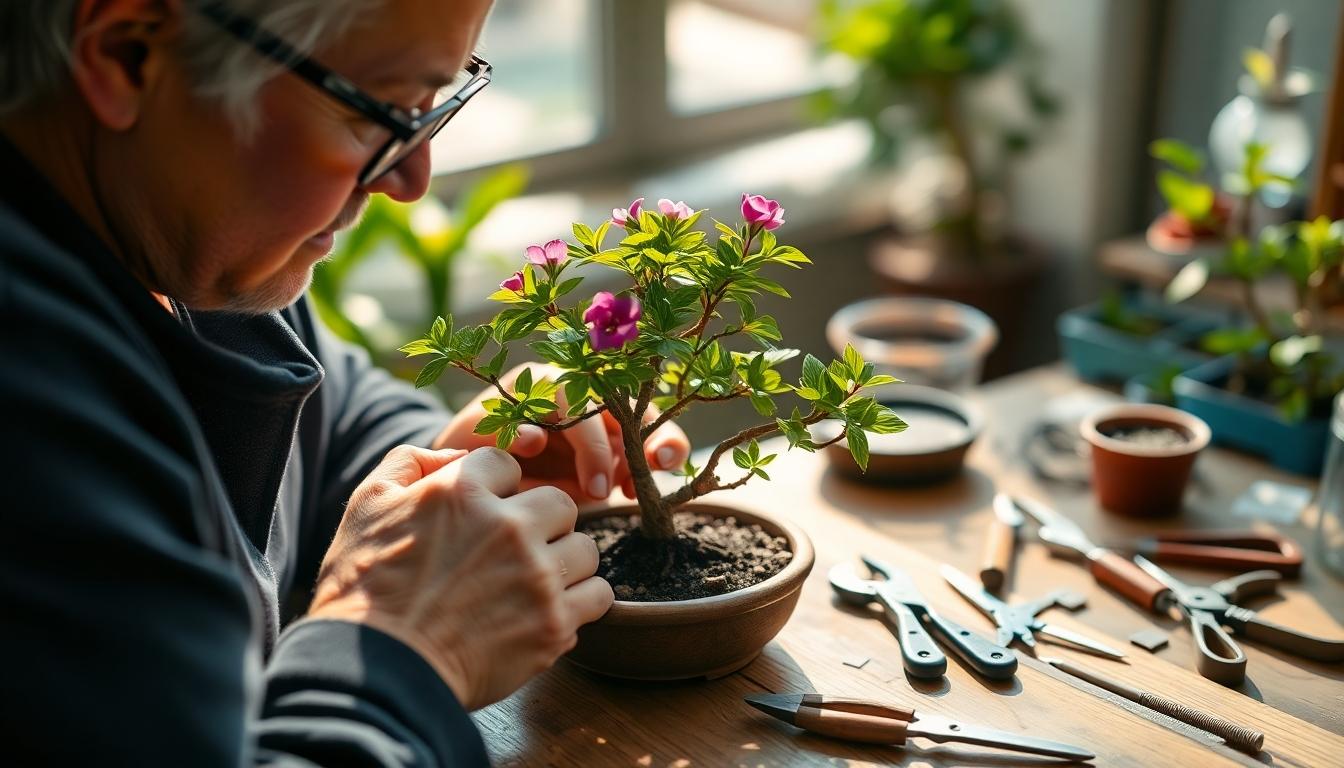
Creating a beautiful vinca bonsai requires exact tools and materials to properly shape and maintain your miniature tree. Let’s explore the essential equipment you’ll need for this rewarding project.
Pruning Equipment and Potting Supplies
Bonsai Pruning Shears serve as your primary tool for trimming branches and carefully shaping your vinca plant. These specialized shears allow for precise cuts that promote healthy regrowth and proper styling. Concave Cutters become invaluable when you need to remove thicker branches, creating clean cuts that heal quickly and minimize scarring. We recommend having a dedicated Root Pruner on hand for essential root maintenance during repotting sessions, ensuring your bonsai develops a compact root system. Wire Cutters complete your basic toolkit, allowing you to safely remove training wire without damaging delicate branches.
For potting, a shallow Bonsai Pot is essential to focus root growth and maintain the desired compact shape of your vinca bonsai. These containers not only serve a functional purpose but also enhance the aesthetic appeal of your finished creation. Potting Mesh should be placed at the drainage holes to prevent soil from washing out while still allowing excess water to escape. Some enthusiasts also use Grafting Tapes when experimenting with different vinca varieties, though this is optional for beginners.
Soil Mixtures and Fertilizers for Bonsai Development
Well-Draining Bonsai Soil forms the foundation of your vinca bonsai’s health. This specialized mixture typically combines peat moss, perlite, and vermiculite to provide excellent aeration while retaining just enough moisture for healthy growth. Akadama or Japanese Clay serves as an excellent soil component, providing structural support for roots while helping prevent root rot, a common issue in bonsai cultivation.
Fertilization plays a crucial role in developing your vinca bonsai. A Balanced Fertilizer with equal proportions (such as 10-10-10 NPK) works well for regular maintenance throughout most of the growing season. During flowering periods or when focusing on root development, switching to a High-Phosphorus Fertilizer can significantly enhance these exact growth phases. Many bonsai enthusiasts prefer Organic Options like compost or manure tea for sustainable growth, providing gentle nutrition without the risk of chemical burn.
Regular watering practices, direct sunlight exposure, and strategic pruning during the growing season will further enhance your vinca bonsai’s development. Applying wire during periods of active growth allows you to effectively shape branches and create your desired bonsai style.
Step-by-Step Process of Converting Vinca to Bonsai Form
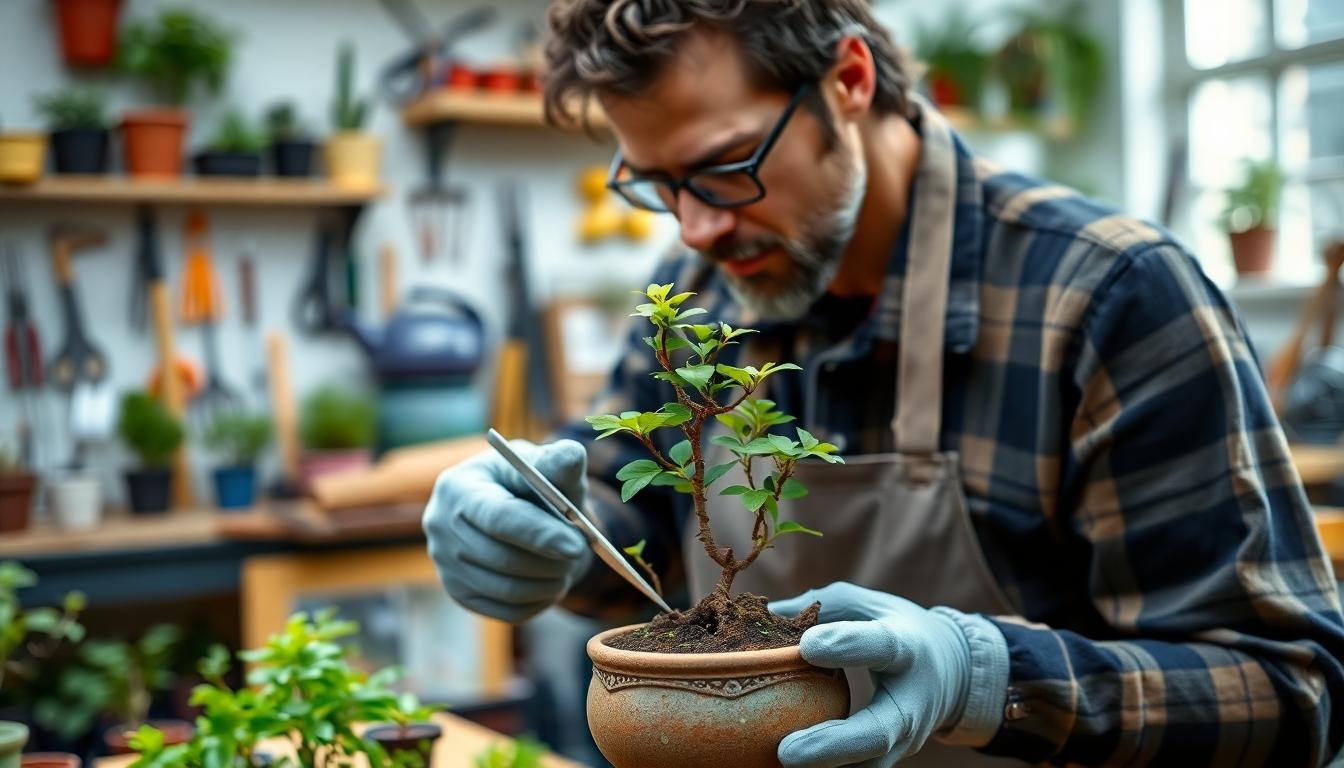
Transforming a vinca plant into a stunning bonsai requires following exact techniques across multiple stages. We’ll guide you through each critical step to help you create your own unique vinca bonsai masterpiece.
Initial Selection and Preparation of Vinca Plants
Selecting the right vinca plants forms the foundation of a successful bonsai project. Look for healthy specimens that display robust growth and multiple stems, as these provide more styling options. Careful initial pruning encourages the plant to develop a bushier habit, which is essential for creating the dense foliage characteristic of attractive bonsai. Before beginning any major work, we recommend letting your vinca establish itself for several weeks if you’ve just purchased it. Remove any damaged or diseased portions of the plant to ensure only healthy tissue remains for your bonsai transformation.
Root Pruning and Potting Techniques
Root management plays a crucial role in developing a proper vinca bonsai. Gently remove the plant from its nursery container and trim back approximately one-third of the root mass, taking care not to damage the central root structure that sustains the plant. Use sharp, clean tools during this process to minimize stress on the plant. Select a shallow bonsai pot that complements the intended style of your creation while allowing for proper drainage. Place drainage mesh over the holes before adding a well-draining bonsai soil mix specifically formulated to balance moisture retention with aeration. Position your vinca in the pot, ensuring it sits at the proper height and angle for your desired design.
Wiring and Shaping Methods for Artistic Expression
Wiring techniques allow for precise control over your vinca’s form and structure. Apply aluminum or copper wire carefully around stems and branches in a spiral pattern, avoiding excessive pressure that might damage the plant. The wires serve as temporary guides that train branches into positions that create visual interest and artistic flow. Regular pruning maintains your desired shape by removing growth that detracts from the overall design. Focus on developing natural-looking branch patterns that suggest age and character. Monitor wired sections frequently to prevent the wire from cutting into growing branches, and remove or reapply wires as needed to accommodate new growth. Training your vinca this way gradually develops the classic bonsai silhouette while preserving the plant’s health and vigor.
Training Your Vinca Bonsai: Techniques and Timeline
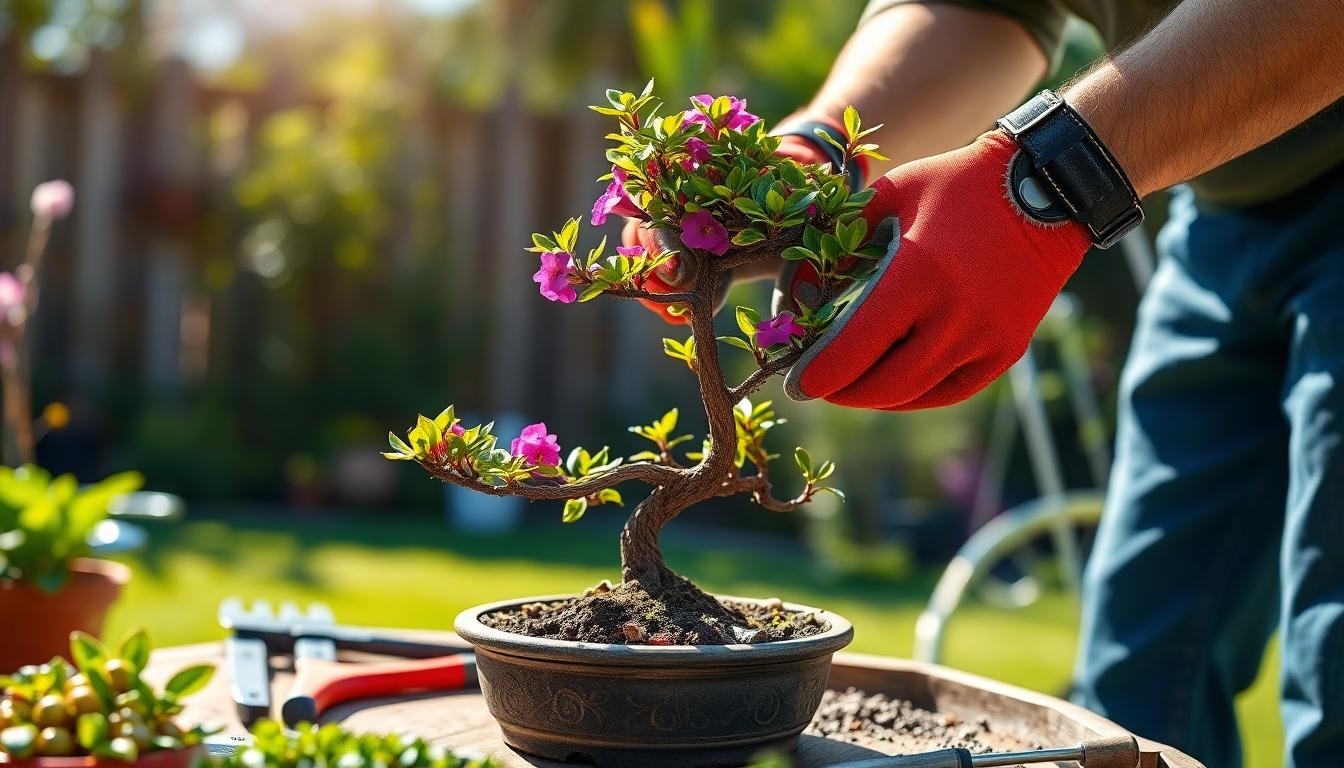
Training a vinca bonsai requires patience, consistency, and proper technique to achieve that miniaturized tree appearance. Let’s explore the essential methods that will transform your vinca into a stunning bonsai masterpiece.
Initial Setup for Vinca Bonsai
When starting your vinca bonsai journey, plant selection is crucial. Choose a healthy Vinca plant with a sturdy stem, as this will form the foundation of your bonsai. The stronger the main stem, the better it will mimic a mature tree trunk when properly trained.
For potting, place your selected vinca in a shallow bonsai pot that provides good drainage. Proper drainage prevents root rot and ensures your bonsai maintains optimal health throughout its development stages.
Progressive Pruning Strategies for Miniaturization
Basic pruning forms the first step in training your vinca bonsai. Remove any dead or damaged leaves and stems to maintain plant health and encourage vibrant new growth. This initial cleanup allows the plant to direct energy toward developing areas that will enhance its bonsai form.
Shaping pruning must be performed regularly to guide your vinca into the desired bonsai style. Focus on maintaining symmetry and aesthetic balance while removing growth that doesn’t contribute to your design vision. Regular trimming encourages branching and helps develop a more tree-like appearance.
Leaf pruning techniques involve cutting back foliage strategically to encourage bushier growth. This method creates a fuller appearance and helps your vinca bonsai develop the dense canopy characteristic of mature miniature trees. We recommend performing leaf pruning during active growth periods for best results.
Defoliation and Branch Refinement Practices
Defoliation serves as an advanced technique for vinca bonsai training. Temporarily removing leaves promotes new growth and refines branching patterns. This should only be performed during active growth phases to prevent undue stress on the plant. After defoliation, your vinca will respond with smaller, more proportionate leaves that enhance its miniature appearance.
Branch refinement requires precision and attention to detail. Use thinning cuts to remove excess branches and refine the overall shape of your bonsai. Wire branches gently to maintain desired positions without causing damage to the plant’s structure. The wiring process allows you to create more natural-looking curves and angles that mimic aged trees in nature.
Timeline for Shaping and Care
During years 1-2, focus on establishing strong roots and basic structure through consistent pruning. This foundation period determines the long-term success of your vinca bonsai, so don’t rush the development process.
In years 3-5, begin more detailed shaping with wire as the trunk and branches become more established. Your bonsai will start displaying more character and definition during this period as it matures into its designed form.
Yearly repotting in late winter helps maintain healthy roots and refreshes the soil. This practice prevents root binding and ensures your vinca bonsai continues to receive proper nutrition for sustained growth and development.
Additional Considerations
Seasonal care adjustments are essential for vinca bonsai health. Modify your watering and fertilization routines based on seasonal changes to provide optimal growing conditions year-round. During summer months, more frequent watering may be necessary, while winter typically requires reduced watering and fertilization.
Protection from extreme weather conditions prevents damage to your bonsai. Vinca bonsai should be shielded from frost, excessive heat, and strong winds that could compromise its carefully cultivated form. A sheltered location or temporary indoor placement during harsh weather will safeguard your living artwork.
Maintaining Your Vinca Bonsai’s Health and Appearance
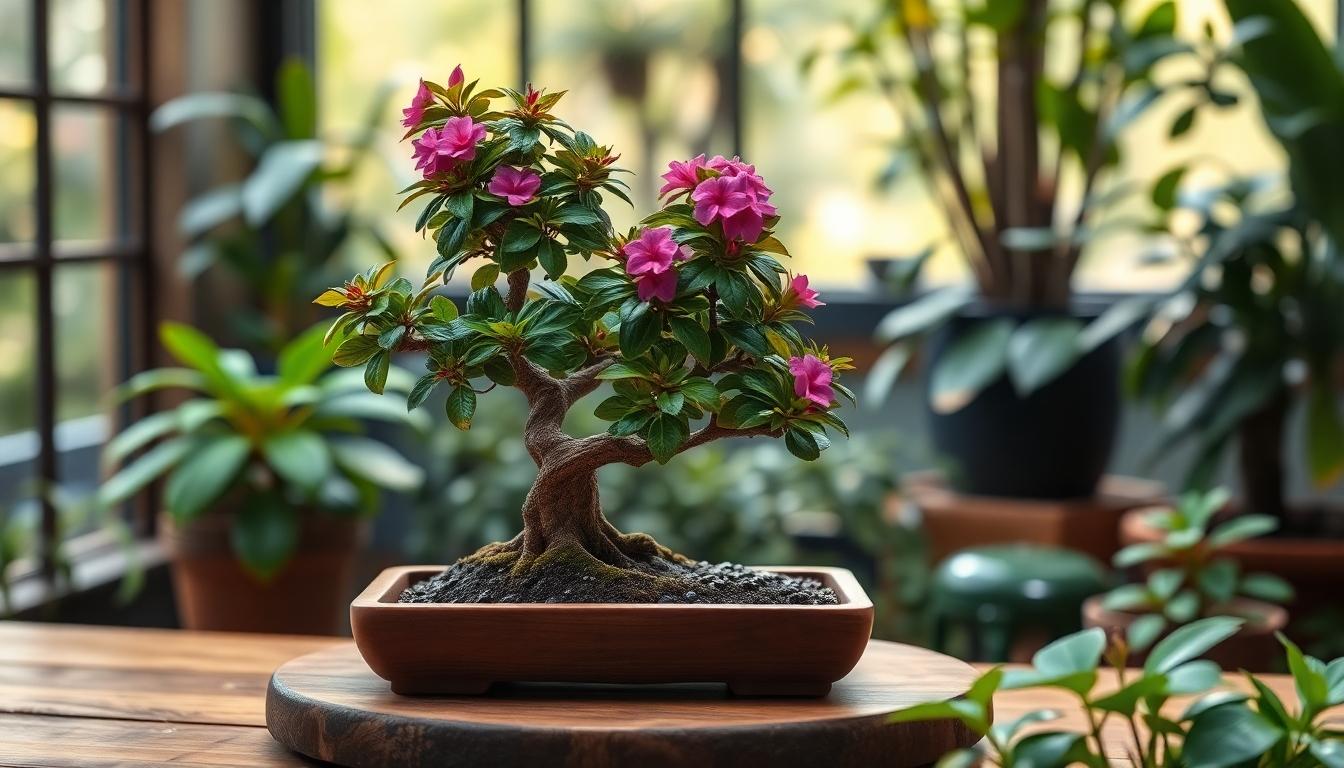
Once you’ve transformed your vinca into a beautiful bonsai, proper maintenance becomes essential for keeping your miniature tree healthy and aesthetically pleasing. Let’s explore the exact care requirements that will help your vinca bonsai thrive.
Watering Requirements and Humidity Control
Vinca bonsai trees require consistent moisture without becoming waterlogged. Check the topsoil regularly and water thoroughly when it feels dry to the touch. Always ensure excess water drains freely from your bonsai pot to prevent root problems. Shallow bonsai containers tend to dry out faster than conventional pots, so vigilant monitoring is necessary to prevent the soil from drying completely.
For humidity management, placing your vinca bonsai on humidity trays can create a microclimate that benefits the plant, especially during dry seasons. Occasional misting helps maintain adequate moisture levels around the foliage, though this shouldn’t replace proper watering practices. Your bonsai will appreciate this extra humidity, particularly when indoor heating or air conditioning reduces ambient moisture.
Seasonal Care Guidelines and Protection Methods
Spring and summer represent prime growing seasons for vinca bonsai. During these months, apply balanced liquid fertilizer every 2-4 weeks to support robust growth. Take advantage of this active period to perform aggressive pruning and shaping work, as the plant will readily respond with new growth that can be trained into your desired form.
As autumn approaches and growth slows down, reduce your watering frequency accordingly. Protect your vinca bonsai from temperatures below 50°F (10°C), as these plants are notably frost-sensitive. Moving indoor or to a protected location becomes essential during colder months to prevent damage.
Regular inspection for pests like aphids and conditions such as root rot should become part of your maintenance routine. Improving airflow around your bonsai and avoiding overwatering serve as effective preventative measures against fungal issues. Position your vinca in bright, indirect light, adjusting shade during peak summer months to prevent leaf scorching.
Every 2-3 years, plan to repot your vinca bonsai, trimming approximately one-third of the roots to maintain its miniature form. This practice refreshes the soil and prevents your plant from becoming root-bound. For aesthetic enhancement, apply wiring during active growth periods to guide branch development, pinch back new shoots to encourage bushier foliage, and thin leaves seasonally to improve light penetration throughout the canopy structure.
Common Challenges When Transforming Vinca to Bonsai
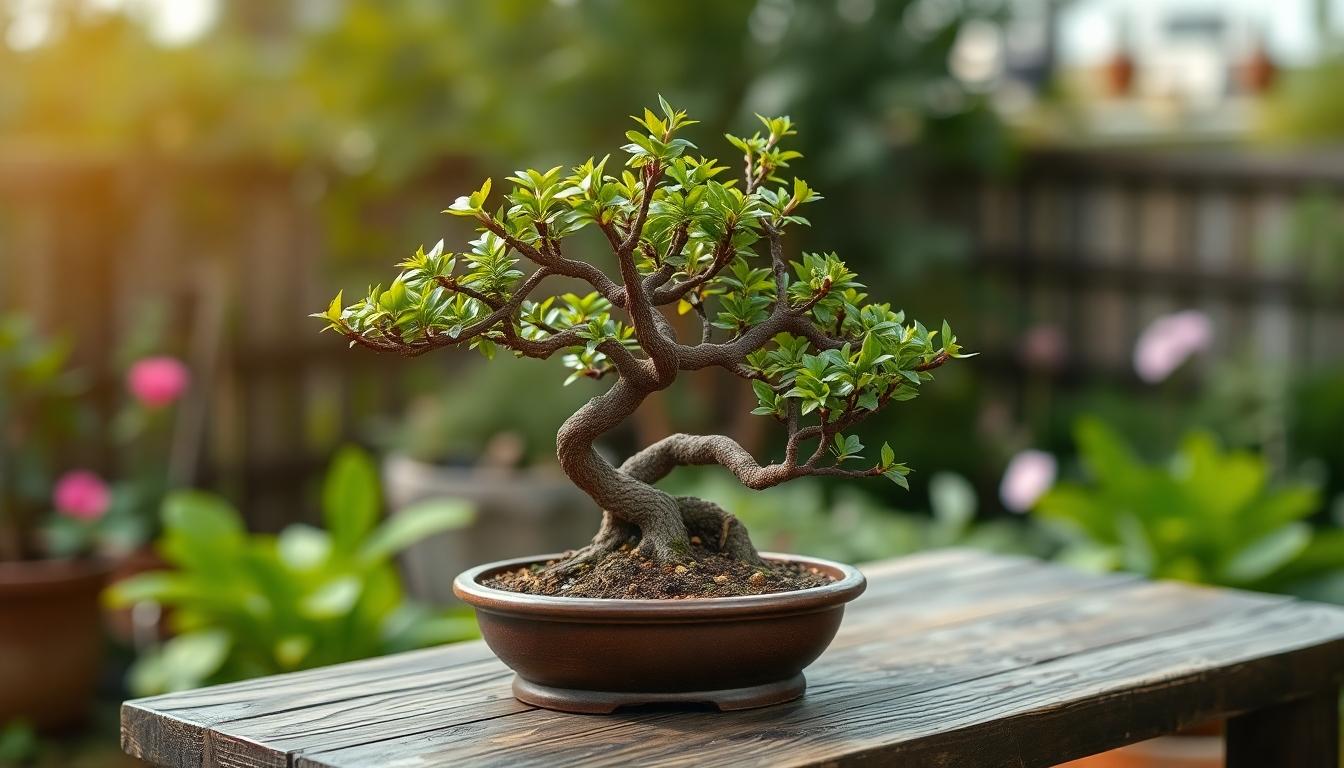
Transforming a Vinca plant into a bonsai tree presents several unique challenges that require patience and skill to overcome. The natural growth habits of Vinca as a ground cover or shrub rather than a tree make structural training particularly demanding.
Pest Management and Disease Prevention
Maintaining pest-free Vinca bonsai requires vigilant monitoring and prompt intervention. Aphids and spider mites frequently colonize the undersides of leaves, necessitating regular inspection of your bonsai. We recommend applying general-purpose insecticides thoroughly to all plant surfaces—including leaves, branches, and trunk—to effectively eliminate these common pests. Following product instructions for repeated applications is essential for preventing reinfestation.
Disease issues in Vinca bonsai typically stem from improper watering practices and poor air circulation. Root rot and fungal infections commonly develop when soil remains waterlogged for extended periods. To prevent these problems, we suggest keeping the soil just damp rather than saturated and ensuring your bonsai pot has excellent drainage. Good hygiene practices and periodic repotting with fresh soil significantly reduce disease risk and promote overall plant health.
Troubleshooting Growth and Development Issues
Stunted growth in Vinca bonsai often indicates the plant has become pot-bound. When roots completely fill the container, nutrient uptake becomes limited and growth slows dramatically. Addressing this issue requires either repotting into a slightly larger container or carefully pruning approximately 15% of the root mass before replanting in fresh soil.
Leaf problems signal various environmental stressors affecting your bonsai. Discoloration, brittleness, or unexpected leaf drop may result from improper watering, excessive heat exposure, or nutrient deficiencies. Checking the cambium layer beneath the bark provides valuable information about your tree’s vitality—green indicates healthy tissue, while brown suggests damage from factors like drought stress.
Daily monitoring of soil moisture and light exposure proves crucial for early problem detection. We find that misting during hot weather helps prevent leaf wilting and burn damage. Adjusting your bonsai’s position to optimize light without causing heat stress greatly improves its chances of developing into a healthy miniature tree while maintaining the distinctive characteristics that make Vinca bonsai so appealing.
Styling Options for Vinca Bonsai Trees
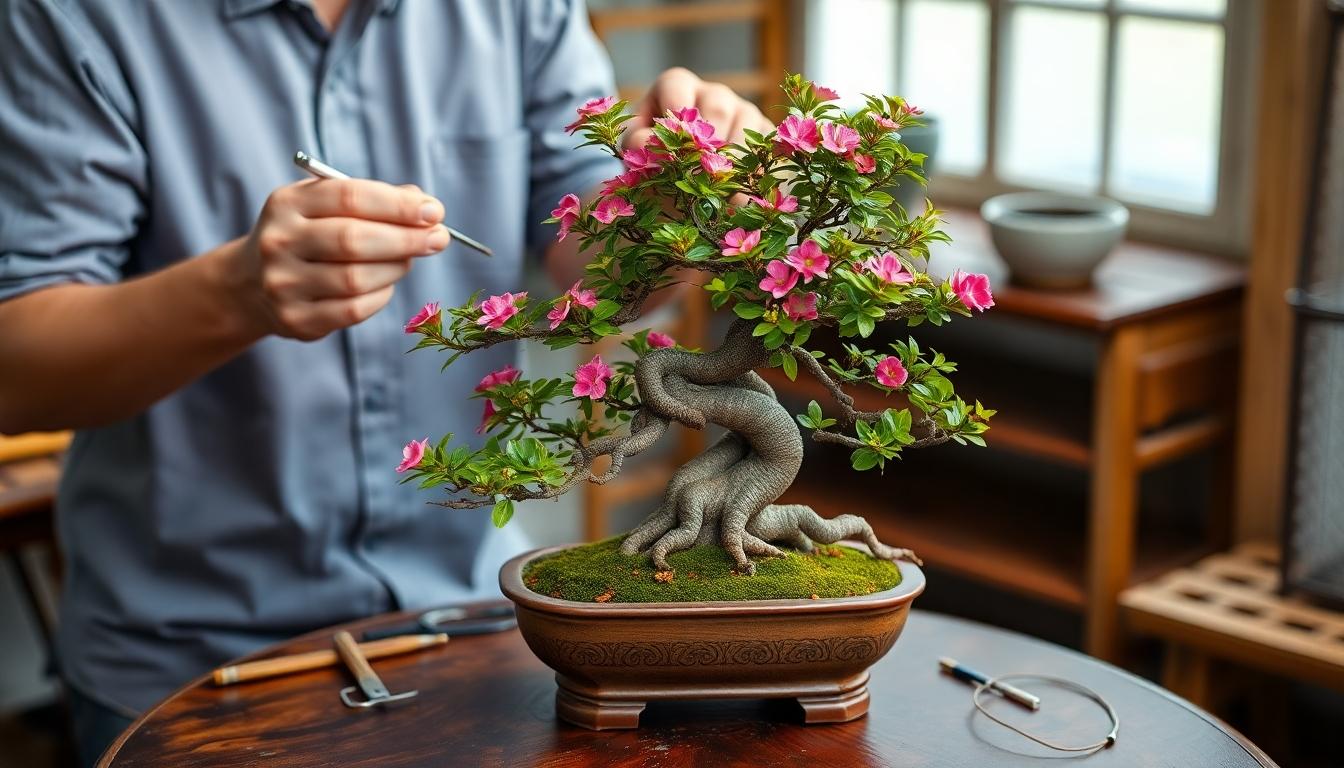
Vinca plants offer tremendous versatility when styled as bonsai, allowing both traditional and contemporary artistic expressions. We’ve compiled the most effective styling approaches that showcase vinca’s unique characteristics and growth patterns.
Traditional Japanese Bonsai Styles Suitable for Vinca
Formal Upright (Chokkan) styling transforms vinca into a dignified bonsai with a straight trunk and symmetrical branching. This classical approach requires regular wiring due to vinca’s naturally flexible stems, but creates an impressive formal appearance. Informal Upright (Moyogi) offers a more relaxed interpretation with a gently curved trunk that actually complements vinca’s natural flexibility. The slight curves create visual interest while maintaining the tree’s overall vertical orientation.
Cascade (Kengai) styling takes advantage of vinca’s trailing growth habit, directing branches to flow downward over the pot’s edge. This dramatic style mimics trees growing on mountainsides and perfectly suits vinca’s natural tendency to spread. Root Over Rock (Seki-joju) creates a striking visual where the roots embrace and flow over stone surfaces, challenging to achieve but remarkable when successful with vinca’s extensive root system. Windswept (Fukinagashi) styling mimics trees shaped by constant winds, with branches flowing dramatically in one direction – an effect vinca’s trailing habit naturally accommodates.
Creating Unique and Contemporary Vinca Bonsai Designs
Vinca’s rapid growth rate and adaptability make it perfect for innovative bonsai designs beyond traditional Japanese styles. Air-layering techniques create multi-trunked specimens by encouraging new root development along existing branches, resulting in unique forest-like arrangements. Mosaic Planting combines vinca with complementary species to create visually ever-changing compositions that highlight contrasting textures and colors.
Abstract Styling breaks conventional rules to explore unconventional shapes and forms that showcase vinca’s versatility. This approach emphasizes artistic expression over traditional bonsai principles, allowing the plant’s natural flowering capacity and dense foliage to shine. Regular pruning and selective wiring maintain these creative designs while taking full advantage of vinca’s vigorous growth patterns and visual appeal.
Displaying Your Vinca Bonsai: Presentation and Aesthetics

The visual presentation of your vinca bonsai is just as important as the cultivation process itself. Strategic display choices enhance the artistic impact of your miniature tree while showcasing the unique characteristics of the vinca plant.
Choosing Complementary Pots and Display Stands
Selecting the right container for your vinca bonsai significantly impacts its overall aesthetic appeal. Shallow pots with proper drainage holes are essential to mimic traditional bonsai conventions while supporting vinca’s growth requirements. Earth-toned ceramic or terracotta containers create a beautiful contrast with vinca’s vibrant pink, white, or red flowers while complementing its woody stems naturally. For optimal visual presentation, choose pots approximately one-third the height of your bonsai tree to maintain proper proportions.
Elevation plays a crucial role in proper bonsai display techniques. Wooden or stone display stands lift your vinca bonsai to eye level, creating visual hierarchy and allowing viewers to appreciate its detail. Placement requires careful consideration of light conditions, as vinca thrives in sunlight but needs protection from extreme weather elements. Regular rotation of your bonsai ensures balanced light exposure from all angles, promoting uniform growth patterns and maintaining the tree’s designed shape.
Creating Harmonious Arrangements with Other Plants
Vinca bonsai displays become more impressive when thoughtfully paired with complementary plants. Low-growing ground covers like moss or small succulents create a miniature industry effect that enhances the bonsai’s tree-like appearance. Negative space around your vinca bonsai is crucial—avoid overcrowding to ensure the tree’s structure remains the focal point of your arrangement.
Outdoor displays benefit from grouping vinca bonsai with other drought-tolerant species that share similar care requirements. Sedums or portulacas make excellent companions since they mirror vinca’s sun-loving nature without competing for visual attention. Indoor arrangements near east-facing windows optimize light conditions without risking leaf scorch from harsh direct sunlight.
Aesthetic enhancements can further elevate your display’s impact. Miniature figurines or carefully selected rocks create thematic scenes that complement rather than overshadow your bonsai. Seasonal adjustments to your display should include reducing watering during winter months and providing adequate protection from frost, as vinca bonsai are particularly frost-sensitive even though their general hardiness.
Conclusion: The Rewards of Transforming Vinca to Bonsai
Transforming vinca into bonsai offers a rewarding journey that’s accessible for enthusiasts at all levels. We’ve seen how these resilient plants provide unique styling opportunities with their semi-woody stems and vibrant blooms.
The beauty of vinca bonsai lies in its versatility. Whether you prefer traditional Japanese styles or contemporary artistic expressions the plant adapts beautifully to your vision with proper care and training.
Remember that patience is key. As your vinca bonsai develops it will reward you with a distinctive character that evolves through the seasons. We encourage you to experiment with this often-overlooked species and discover the artistic possibilities waiting in these remarkable plants.
Frequently Asked Questions
Can any variety of vinca be turned into a bonsai?
Yes, most vinca varieties can be transformed into bonsai, though Vinca minor, Vinca major, and Catharanthus roseus are particularly suitable. These varieties develop woody stems, produce vibrant flowers, and have flexible growth habits that respond well to training. Their natural characteristics, including spreading foliage and semi-woody stems, make them excellent candidates for bonsai styling.
How long does it take to transform a vinca plant into a bonsai?
A vinca plant can show bonsai characteristics within 4-6 months with proper training, but developing a mature-looking specimen typically takes 1-2 years. The first year focuses on establishing strong roots and basic structure, while the second year allows for more detailed shaping and refinement. Vincas transform relatively quickly compared to traditional bonsai species.
What type of soil is best for vinca bonsai?
Use a well-draining bonsai soil mix with approximately 60% inorganic material (like akadama, pumice, or lava rock) and 40% organic material (like pine bark or peat moss). This balance provides adequate drainage while retaining enough moisture for healthy growth. Avoid regular garden soil, which can become compacted and cause root rot in shallow bonsai containers.
How often should I water my vinca bonsai?
Water your vinca bonsai when the top half-inch of soil feels dry to the touch, typically every 2-3 days during growing season and less frequently in winter. Never let the soil completely dry out or become waterlogged. Using a humidity tray and occasional misting can help maintain proper moisture levels, especially indoors or in dry climates.
Do vinca bonsai require special fertilizer?
Vinca bonsai benefit from balanced, diluted fertilizer (NPK 10-10-10 or similar) applied every two weeks during the growing season (spring through early fall). Reduce fertilization in late fall and winter when growth slows. Liquid fertilizers work well, but slow-release options can also be effective when applied according to package directions at half-strength.
What are the best styling options for vinca bonsai?
Vinca plants work well in several bonsai styles including Formal Upright, Informal Upright, Cascade, and Windswept designs. Their flexible stems are ideal for creating movement in the trunk and branches. Root-over-rock styles can be particularly striking with vincas, as can multi-trunk arrangements. Consider styling that showcases both the woody structure and the plant’s flowering capabilities.
How do I deal with pests on my vinca bonsai?
Monitor regularly for common pests like aphids, spider mites, and scale insects. Treat minor infestations by spraying with insecticidal soap or neem oil solution, being sure to cover all plant surfaces including the undersides of leaves. For prevention, maintain good air circulation and avoid overwatering. Remove severely affected leaves and isolate infected plants from your collection.
When is the best time to prune a vinca bonsai?
The ideal pruning time is early spring just before new growth emerges, with maintenance pruning throughout the growing season. Remove no more than one-third of the foliage at once to avoid stressing the plant. Pinch back new growth regularly to encourage ramification and maintain the desired shape. Avoid heavy pruning during flowering periods or in late fall.
Can vinca bonsai survive winter outdoors?
Vinca bonsai can tolerate mild winters (USDA zones 7-9) but should be protected when temperatures approach freezing. In colder regions, move plants to an unheated garage, cold frame, or buried pot garden during winter. Reduce watering but don’t allow the soil to completely dry out. For areas with harsh winters, keeping vinca bonsai as indoor specimens is recommended.
How often should I repot my vinca bonsai?
Repot young vinca bonsai every 1-2 years and mature specimens every 2-3 years, preferably in early spring before new growth begins. During repotting, trim approximately one-third of the roots and refresh the soil completely. Use a container only slightly larger than the previous one to maintain the bonsai’s compact form while allowing for healthy root development.

